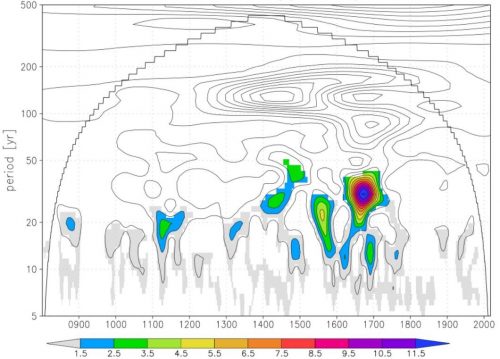Wavelet power spectrum of the reconstructed snowfall severity index in the Mediterranean along the past millennium

Note the location of significant edge effects around the cycles of 22 and 11 years (coloured bands). The graphs were supplied by the web-GIS Climate Explorer, courtesy of the Royal Netherlands Meteorological Institute (van Oldenborgh GJ, Drijfhout S, van Ulden A, Haarsma R and others, 2009. Western Europe is warming much faster than expected. Clim Past 5:1–12).
Submitter: Nazzareno Diodato, Met European Research Observatory
Area of Research: Hydroclimate
GEWEX Panel: GEWEX Hydroclimatology Panel (GHP)
Journal Reference
Diodato N., Büntgen U., Bellocchi G., 2019. Mediterranean winter snowfall variability over the past Millennium. International Journal of Climatology 39, 384-394.
Science
Snowfall is a key component of the Earth system that has important climatic, ecological and societal implications. Then, documenting the interannual variability of snowfall in historical times is important not only for detecting signals of climate change in time series but also for validating climate models and for understanding better the interactions between climate and cryosphere.
Impact
With the longest annually-resolved snowfall time series compiled for Italy (AD 800-2017), which is also the Mediterranean longest, this study provides an unprecedented high-resolution snowfall records from documentary sources. It gives a perspective on millennium-long snowfall variability in the Mediterranean and a unique winter proxy for validating output from climate model simulations.
Summary
Our analysis suggests that predominantly positive patterns of the Atlantic Multidecadal Variability (AMV) determined a pattern of low snowfall intensity during the Medieval Climate Anomaly (MCA). The snowfall reconstruction for the 20-21th centuries shows a comparable course with the MCA, both characterized by overall sustained warm intervals in Northern Hemisphere regions, retreating glaciers and weakening of the Siberian anticyclone. Cold anomalies in the Little Ice Age (LIA), by contrast, were found to be associated with the presence of negative AMV phases, during periods of frequent volcanic eruptions and low solar irradiance. The co-occurrence of these events caused record-breaking declines of temperature, concomitant with heavy snowfall across Europe. The occurrence of low-snowfall years has become widespread in recent decades, revealing however that this period is likely not unprecedented in the long-term record.
Link to the Original Research Publication or Website:
https://rmets.onlinelibrary.wiley.com/doi/10.1002/joc.5814

